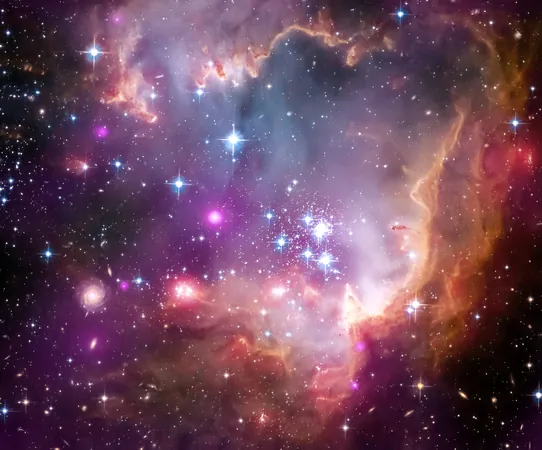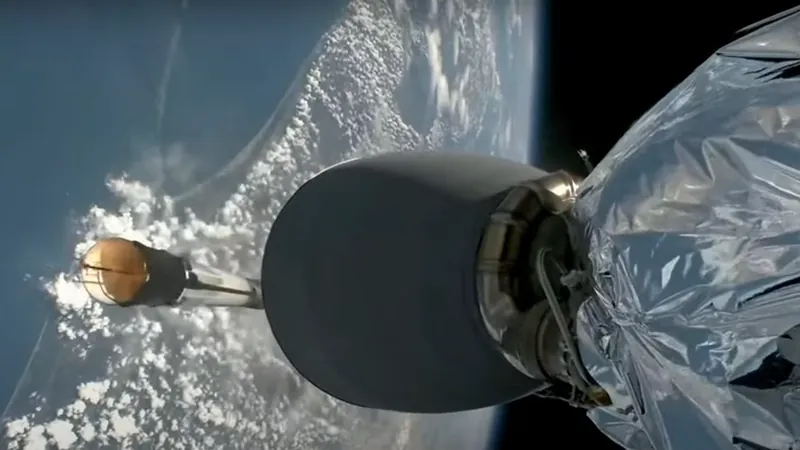
Galactic Tug-of-War: The Small Magellanic Cloud Being Torn Apart!
2025-05-25
Author: Arjun
The Small Magellanic Cloud's Cosmic Struggles
The Small Magellanic Cloud (SMC), a captivating dwarf galaxy located approximately 200,000 light-years from Earth, is embroiled in an astonishing gravitational conflict. This celestial neighbor to the Milky Way is not just quietly orbiting; it's thrillingly being tugged and pulled by the immense forces of surrounding galaxies!
A Shocking Discovery: Opposing Star Flows
Recent studies reveal a stunning phenomenon within the SMC's stars—they show two separate, opposing flows! Dr. Kengo Tachihara from Nagoya University connects these movements to awe-inspiring gravitational effects from neighboring massive galaxies, suggesting the SMC is caught in an intriguing cosmic ballet.
Distance Matters in Space—A New Approach!
To uncover the secrets of this stellar motion, scientists have turned to cepheid variable stars, the universe's own cosmic yardsticks. Relying on high-precision data from the Gaia mission, researchers discovered that stars closer to Earth and those further away exhibit drastically different movements, offering fresh insights into the SMC's dynamics.
Dynamic Forces at Play: The Stretching Effect
While the Large Magellanic Cloud exerts a gravitational pull on the SMC, there might be even more going on. Dr. Tachihara points to potential influences from our very own Milky Way and disturbances from historical encounters between the two Magellanic Clouds. This interaction hints at a galactic tug-of-war that reshapes and distorts the structure of the SMC.
The Evolution of Dwarf Galaxies: A New Perspective
Previous models suggested that the SMC rotated like a conventional spinning disk. However, groundbreaking analyses show a lack of significant rotation, instead suggesting that external forces are sculpting its behavior. This revelation prompts calls for new simulations that factor in the SMC’s unique characteristics.
What This Means for Galaxy Formation!
The findings not only challenge existing theories about dwarf galaxies but also help explain larger cosmic processes. Understanding how smaller galaxies evolve under the influence of massive neighbors can provide key insights into the formation of stars and the evolution of galaxies throughout the universe.
Future Research: A Cosmic Investigation!
Scientists are gearing up for exciting new data comparisons from advanced observatories to uncover if other dwarf galaxies face similar gravitational stresses. Better mapping of radial velocity will allow astronomers to decipher whether parts of the SMC are indeed pulled in contrasting directions, potentially revealing hidden cosmic interactions.
Expanding Our Understanding of Galaxies
The implications of this study extend beyond the SMC itself. As cosmologists delve deeper into the motion and interaction of dwarf galaxies, they hope to uncover how these celestial bodies respond to gravitational encounters over cosmic timescales. Such knowledge could redefine our understanding of galaxy families across the cosmos.
Conclusion: A New Chapter in Cosmic Studies!
The latest research, published in The Astrophysical Journal Letters, illuminates a fascinating interplay between galaxies that adds depth to our comprehension of the universe. With each observation and theory, we edge closer to unveiling the mysteries of how small galaxies like the SMC navigate the vast cosmic sea.





 Brasil (PT)
Brasil (PT)
 Canada (EN)
Canada (EN)
 Chile (ES)
Chile (ES)
 Česko (CS)
Česko (CS)
 대한민국 (KO)
대한민국 (KO)
 España (ES)
España (ES)
 France (FR)
France (FR)
 Hong Kong (EN)
Hong Kong (EN)
 Italia (IT)
Italia (IT)
 日本 (JA)
日本 (JA)
 Magyarország (HU)
Magyarország (HU)
 Norge (NO)
Norge (NO)
 Polska (PL)
Polska (PL)
 Schweiz (DE)
Schweiz (DE)
 Singapore (EN)
Singapore (EN)
 Sverige (SV)
Sverige (SV)
 Suomi (FI)
Suomi (FI)
 Türkiye (TR)
Türkiye (TR)
 الإمارات العربية المتحدة (AR)
الإمارات العربية المتحدة (AR)